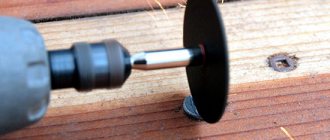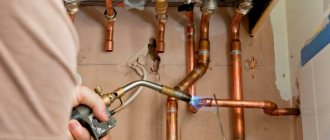Use abrasive powder
As with steel wool, the more grip between the screw head and the screwdriver, the better. You can sprinkle the surface of the screw with a small amount of abrasive scouring powder or fine sand, then apply a screwdriver to the screw and try to remove it. In many cases, powder or sand is enough to keep the bit from slipping off the screw.
Why are the edges of the screw torn off?
There are several negative factors that explain why the head does not unscrew:
- corrosion of the metal, as a result the structure of the material is disrupted, it loses its properties, becomes less durable, crumbles, this leads to the fact that during the repair the technician will not be able to dismantle it by unscrewing the rusty fasteners;
- a screw tends to spin if it has been installed in a structure made of the wrong material.
The problem of how to unscrew a screw arises when the rules for using the tool are violated.
The problem occurs when the rules for using the tool are violated
crosshead screwdriver
Possible causes of fastener damage:
- poor quality of the tool: the metal is too soft, which causes the screwdriver to constantly slip out, the sharp edges have become dull due to wear, this also does not allow the screw to be firmly fixed in the slot, in addition, the tool may be incorrectly selected for such work (does not match the head size);
- weak efforts in the process of unscrewing the fastener, while the screwdriver is not held in the slot, constantly slips, as a result the head is deformed, for this reason it is called “slipped”;
- At the installation stage, the fasteners were installed in a structure made of a material that does not match the screws, because of this it rotates; using a screwdriver it will not be possible to pull out such hardware.
The tool may not be selected correctly for the job.
Screwdriver bit
A common problem with using power tools is the incorrect choice of operating speed. Use moderate force to drill out the fasteners. The operating time of the screwdriver should be short. If you drill a screw intensively, the slot will become deformed. As a result, you will have to additionally decide how to unscrew a screw with a damaged head, which will increase the time it takes to complete the work.
If you drill a screw intensively, the slot will become deformed.
Drill the screw
Select a drill bit that is slightly smaller in diameter than the screw head. Place it in the center of the screw head and drill slowly to create a hole 1 to 3mm deep. Remove the drill from the screwdriver and install the cue ball. Often the hole will help the screwdriver go deep enough into the screw, which will improve the grip between the cue ball and the screw.
Traditional methods
These methods are considered universal, but sometimes require much more time than using special tools.
Sets of wrenches: open-end, socket and socket
Working dimensions should not be “broken”, free wobble on a bolt or nut should not exceed 0.5 mm.
The tighter the key sits, the larger the stop area, the more force you can apply.
The size and type of the key are selected depending on the location of the hardware - it is necessary to ensure not only a tight fit, but also the ability to create a large twisting torque.
It is recommended to hit the bolt with a hammer while unscrewing it.
Use elastic bands to grip
Wide rubber bands work well to ensure that the screwdriver has enough grip on the stripped screw. Cut the rubber band with scissors and place it on the head of the screw. Place the screwdriver on the rubber band and press firmly while turning the screw counterclockwise.
Follow us on Pinterest for more interesting articles.
Useful short videos from Make-Self.net
Where to begin
Assess the degree of complexity of the problem: if the stripped screw is recessed into the structure of the material, complex methods are considered; To remove the fastener at the screwing stage, use pliers - they grab the head and unscrew it.
Before starting the product removal procedure, check that the screwdriver is selected correctly. To do this, check all types of tools. If the screwdriver is initially selected incorrectly, then you will not need to perform complex procedures for removing the fasteners. The problem will be solved by replacing the tool.
Precautionary measures
When choosing a way to unscrew a screw with torn edges, you must follow the recommendations:
- when using an auxiliary tool, you should control the intensity of the applied forces: sometimes, in order to remove the fastener faster, you have to press harder on it, but the situation will worsen in this case and, conversely, too careful actions with weak pressure will lead to even faster erasure of the edges of the slot;
- when the fastener is unscrewed too intensively or an auxiliary tool is used, during work with which metal shavings are formed (a hacksaw, etc.), it is necessary to periodically remove them, since the presence of foreign particles causes the tool to not fit tightly enough to the edges of the slot, what will slow down the work;
- It is recommended to wear safety glasses when removing a screw without a head, since during the procedure, metal shavings may form when using a power tool;
- you need to know which way to unscrew the screw, so, in most cases, hardware is made with a right-hand thread, which makes it possible to install the fastener by screwing it clockwise, and it is removed, on the contrary, when the screwdriver moves in the opposite direction.
When using an auxiliary tool, the intensity of the applied effort should be controlled
Rusty screw
Before tackling the question of how to unscrew a self-tapping screw that is susceptible to corrosion, you should consider all available methods:
- a blow to the fastener, in this case the integrity of the rust shell is violated, thanks to the vibration created by this, it will be easier to unscrew the rusted screw;
- use of an impact tool: the resulting effect is the same as in the first case; a manual or mechanical impact screwdriver is suitable;
- If the question is how to unscrew a broken screw, which, when trying to remove it, scrolls, and is also covered with rust, you should use the heating method, in which case the metal expands; after cooling, the product will shrink to its original size, as a result, the integrity of the rust shell is damaged, which allows you to quickly remove fasteners;
- an alternative method is the use of the chemical WD-40, a rust converter is used, which destroys the formed shell, however, a positive result can only be obtained if the entire surface of the screw is treated, this condition is often difficult to fulfill.
If corrosion occurs, all available methods should be considered.
Extractor
If the previous methods did not produce an effect, you can use an extractor. It looks like a metal rod with a screw thread and is designed specifically for unscrewing stuck bolts and screws. Before using the tool, a vertical hole is drilled in the screw with a thin drill. The screw end of the extractor is inserted there and first turned slowly, achieving a strong fixation. Then unscrew the screw. The advantage of this method is that it does not damage the material from which the embedded fastener is removed. This method can be used to unscrew almost all types of fasteners, with the exception of self-tapping screws made of hardened steel. In such material it is almost impossible to drill a thin hole for the extractor; the drill will go to the side.
Tool change
If the screwdriver constantly jumps off the slot, the reason may be that the tip is worn out. In this case, the tool is replaced. A new screwdriver is inserted into the screw head, making sure that the tip is pressed tightly against the slot, firmly inserted into the grooves, and try to unscrew the fastener.
Useful advice from Novate.ru: If the fastener cannot be unscrewed, the first thing to do is stop. Attempts to continue unscrewing can aggravate the situation, and a screwdriver that constantly jumps off can damage the material. Assess the condition of the screw and try other removal methods.
Why is a rusty bolt or nut difficult to unscrew?
Any metal fastener inevitably undergoes corrosion and rust over time. The process is accelerated if the bolts and nuts are often exposed to aggressive environments:
- contact with water;
- interaction with chemicals, including detergents;
- street dirt, dust, caustic salts - they accelerate the corrosion process.
Despite special protective coatings against rust, if the surface of the fastener has been even slightly damaged, then over time the process of destruction is inevitable.
After some time, the rusted bolt must be removed and replaced, but a problem often arises - it will not unscrew. Due to the oxidative processes of the metal, rust grows on fasteners and parts and the surfaces “grab” together. If this process develops at the location of the bolt thread, then the situation becomes even more difficult.
How to prevent edges from being torn off
A universal rule is that it is much easier to prevent a problem from occurring than to fix it later. A few basic rules will help you avoid trouble.
Do the following:
- Control the tightening force. As soon as you feel that the bolt is not moving, stop tightening it immediately. The same rule applies to unscrewing hardware.
- Use only serviceable tools. Old broken keys create point loads; the edges of bolts and nuts are not designed to withstand such forces.
- Before tightening, lubricate the thread, especially carefully follow the recommendation for steel hardware.
- Before unscrewing, clean the surfaces of the bolt heads and remove dirt from the screw slots.
- Fix critical components only with new bolts with completely intact head faces.
General advice is to always use a can of WD 40 or an equivalent, this will minimize the risk of edge breakage.











